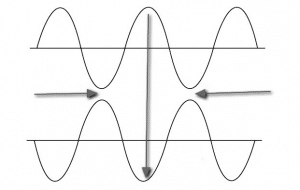What is Phase Cancellation?

If you’ve ever been working with a recording and found that it just sounded bad, it’s very possible that you were hearing phase cancellation. Phase cancellation is a an audio phenomenon where the waves of multiple tracks work against each other to eliminate certain frequencies. The resultant sound is often flat or dull.
Phase cancellation is often overlooked in the mixing process, but it can certainly have a major affect on the outcome of your mix and master. So we thought it’d be good to share some tips on how to fix it.
What is Phase Cancellation?
The basic description of phase cancellation is when you’ve got the waves of two or more signals out of phase with each other. Where the wave on one signal is in it’s peak, another is simultaneously in a trough. Because the peaks and valleys are out of sync, they work against each other rather than supporting each other. The frequencies are cancelled out and, acoustically, it causes a weak sound.
With pro audio phase cancellation can be either electric, where the polarity of the electrical signals are out of phase due to improper wiring, or acoustic, where with sonic waves of multiple tracks are out of phase. We’re going to focus on acoustic here, as getting into troubleshooting electrical phase cancellation requires technical understanding.
How To Prevent Phase Cancellation
You’ll get phase cancellation often when you’re working with multiple mics to record a single instrument, like drums. When mics are positioned improperly you can have an acoustic phase cancellation occur due to one mic being a little further away from the instrument than the other. As a result that mic receives the audio signal a little later than the closer mic.
The best way to fix this is to reposition your mics. If that’s not an option, many modern preamps and interfaces have a reverse polarity feature, which effectively flips the signal’s wave so that the peaks and valleys are inverted.
It also helps to keep your mics positioned a few feet away from walls and floors to avoid out of phase reflected sound bleeding back into your mix.
There are boxes you can purchase that will help fix your phase cancellation by inverting the polarity of the signal. And there are also plugins that can help do the same. However, it’s always better to try and catch it early, which is often a matter of proper mic placement. We’ll talk about that in our next post.




